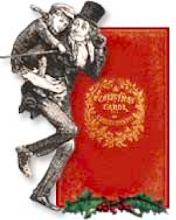At the very end of the beloved Charles Dickens holiday classic A Christmas Carol, a reformed Ebenezer Scrooge and his long-suffering employee Bob Cratchit share an oddly named libation:
“A Merry Christmas, Bob!” said Scrooge with an earnestness that could not be mistaken, as he clapped him on the back. “A merrier Christmas, Bob, my good fellow, than I have given you for many a year! I’ll raise your salary, and endeavor to assist your struggling family, and we will discuss your affairs this very afternoon over a bowl of Smoking Bishop, Bob!”
The drink is hot, spiced wine similar to wassail -- something like a hot sangria, scented with oranges and infused with port. In his book Drinking with Dickens, Cedric Dickens -- the great-grandson of Charles -- tells us that people back in the 1800s enjoyed a whole range of “clerical drinks.”
“Pope is burgundy, Cardinal is champagne or rye, Archbishop is claret, Bishop is port, and so on,” Dickens says.
Here’s Dickens’ “Smoking Bishop” recipe:
• Take six Seville oranges and bake them in a moderate oven until pale brown. If you cannot procure any bitter Seville oranges, use four regular oranges and one large grapefruit.
• Prick each of the oranges with five whole cloves, put them into a warmed ceramic or glass vessel with one-quarter pound of sugar and a bottle of red wine, cover the vessel, and leave it in a warm place for 24 hours.
• Take the oranges out of the mixture, cut in half and squeeze the juice, then pour the juice back into the wine.
• Pour the mixture into a saucepan through a sieve, add a bottle of port, heat (without boiling), and serve in warmed glasses.
• Drink the mixture, and keep Christmas well!
Smoking Bishop - Purple Wine
At the end of A Christmas Carol, Scrooge proposes that he and Bob Cratchit will discuss all that Scrooge will do for Bob’s family later that afternoon “over a bowl of Smoking Bishop."
In his notes for the 1907 edition of A Christmas Carol E. Gordon Browne describes this Christmas punch:
The drink is made by pouring red wine, either hot or cold, upon ripe bitter oranges. The liquor is heated or “mulled” in a vessel with a long funnel, which could be pushed far down into the fire. Sugar and spices (chiefly cloves, star anise, and cinnamon) are added according to taste. It is sometimes called “purple wine” and received the name “Bishop” from its colour.
courtesy of Fr. Mike Klarer
Tuesday, November 10, 2009
Subscribe to:
Post Comments (Atom)

No comments:
Post a Comment